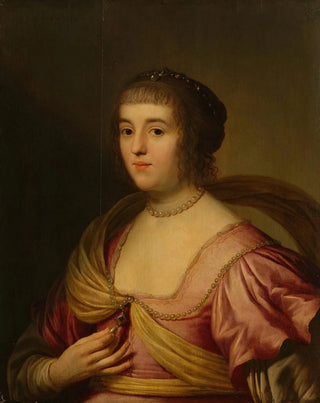Art print | Portrait of Amalia van Solms - Gerard van Honthorst


View from behind

Frame (optional)
Reproduction Portrait of Amalia van Solms - Gerard van Honthorst – Captivating Introduction
The "Portrait of Amalia van Solms" by Gerard van Honthorst is an iconic work that embodies the refinement and sophistication of Dutch Baroque art. This painting, created in the 17th century, does more than depict a historical figure; it tells a story, that of an influential woman and an artist at the height of his craft. Amalia van Solms, wife of Prince Maurice of Nassau, is portrayed with such delicacy and psychological depth that the viewer cannot help but be captivated by her gaze. The light, so characteristic of Honthorst's style, dances across the rich textures of her clothing, revealing the artist's technical mastery while emphasizing the dignity of his subject.
Style and uniqueness of the work
Gerard van Honthorst's style is marked by a bold use of light and shadow, a technique known as chiaroscuro. In the "Portrait of Amalia van Solms," this approach creates an intimate, almost theatrical atmosphere. Amalia's face, illuminated by a soft light, seems to emerge from the shadows, giving her expression a rare emotional intensity. The details of her headdress, adorned with pearls and delicate embroidery, are rendered with precision that testifies to the artist's skill. The dark background, meanwhile, highlights the silhouette of the noble lady, accentuating her status and presence. This work is not limited to a simple representation; it is a true exploration of identity and female power at a time when women often had to stand in the shadow of men.
The artist and his influence
Gerard van Honthorst, born in Utrecht, was one of the most prominent representatives of the Caravaggisti school in the Netherlands. His artistic journey, influenced by Caravaggio himself, led him to develop a unique style that marries the rigor of realism with emotional sensitivity. Honthorst was able to capture the essence of his subjects, whether they were nobles, musicians, or genre scenes, endowing them with palpable humanity. His influence extends well beyond

Matte finish

View from behind

Frame (optional)
Reproduction Portrait of Amalia van Solms - Gerard van Honthorst – Captivating Introduction
The "Portrait of Amalia van Solms" by Gerard van Honthorst is an iconic work that embodies the refinement and sophistication of Dutch Baroque art. This painting, created in the 17th century, does more than depict a historical figure; it tells a story, that of an influential woman and an artist at the height of his craft. Amalia van Solms, wife of Prince Maurice of Nassau, is portrayed with such delicacy and psychological depth that the viewer cannot help but be captivated by her gaze. The light, so characteristic of Honthorst's style, dances across the rich textures of her clothing, revealing the artist's technical mastery while emphasizing the dignity of his subject.
Style and uniqueness of the work
Gerard van Honthorst's style is marked by a bold use of light and shadow, a technique known as chiaroscuro. In the "Portrait of Amalia van Solms," this approach creates an intimate, almost theatrical atmosphere. Amalia's face, illuminated by a soft light, seems to emerge from the shadows, giving her expression a rare emotional intensity. The details of her headdress, adorned with pearls and delicate embroidery, are rendered with precision that testifies to the artist's skill. The dark background, meanwhile, highlights the silhouette of the noble lady, accentuating her status and presence. This work is not limited to a simple representation; it is a true exploration of identity and female power at a time when women often had to stand in the shadow of men.
The artist and his influence
Gerard van Honthorst, born in Utrecht, was one of the most prominent representatives of the Caravaggisti school in the Netherlands. His artistic journey, influenced by Caravaggio himself, led him to develop a unique style that marries the rigor of realism with emotional sensitivity. Honthorst was able to capture the essence of his subjects, whether they were nobles, musicians, or genre scenes, endowing them with palpable humanity. His influence extends well beyond






